As a science teacher at PrepaTec, I teach and develop scientific competency for high school students. Although teachers are convinced of the need to provide students with meaningful contextual learning, science programs are often based on very ambitious instructional goals with many isolated topics that do not interest students. Students learn a method, a formula, or a procedure to answer an exam. Still, they need the transposition of knowledge to know how to apply their theoretical knowledge into practice and understand its connection to their daily lives.
In the search for meaningful learning strategies, I have been implementing the directed inquiry instructional model for three years. This model assumes that to develop profound methodological and attitudinal changes in students beyond conceptual ones, it is necessary to provide them with contextual activities like those experienced by scientists. Although high school students do not have the information, the means, or the time necessary to perform research as a scientist does, according to Pozo and Gómez (1988), starting from elementary and middle school education, we must train and teach students procedures typical of scientific work to provide them with a meaningful context in which they can explore the principles of scientific thinking.
“Every inquiry begins with a question and we have all questioned something at some point. Asking questions and seeking answers to those questions are a natural part of human learning.”
The role of the teacher in directed research is that of the director of inquiry. Our role is to design activities where students must manipulate variables to answer a research question. I am convinced that research is not carried out only by prodigies. Every inquiry begins with a question. We have all wondered about something at some point. Asking and seeking the answers to those questions are a natural part of human learning. Teaching must take the students’ interests as its starting point, seeking to connect scientific tasks with their everyday world, almost without their knowing it. It should not be assumed that to learn science, students must have the attitudes and motives of scientists from the beginning; instead, educators should design teaching to generate these attitudes and motives (Pozo & Gómez, 1988).
Relationship between science education and Artificial Intelligence
Scientific literacy implies that people acquire the knowledge, skills, attitudes, aptitudes, and values that allow them to improve their quality of life, understand and interact with the world and society they are part of, and make decisions about various aspects related to science and technology, as well as appreciating, from an ethical position, the contributions that scientific knowledge has made to improving the quality of human life (Chamizo et al., 2017, p.14). AI is an emerging phenomenon of immense versatility. All people must become AI literate because its applications are not exclusive to a specific area and can be integrated into many human activities.
The scientific community is currently exploring AI as a tool to facilitate research. However, concerns about using Artificial Intelligence (AI) include the bias it can generate on existing data, how it can ensure data security, the appropriate use of data under the scientific method, and identifying whether something is original, fabricated, or a copy (Mullin, 2023). However, researchers also identify opportunities for AI, such as speeding up some research processes by leveraging technological advances in robotics. The University of Liverpool developed an assistant robot in the chemistry lab that can independently perform time-consuming tasks and experiments. This allows the scientific process to progress while giving researchers more time to think creatively about research breakthroughs (World Economic Forum, 2020). The AI field is just emerging, and the possibilities are endless.
Integrating directed-inquiry AI into the classroom
Minor investigations are activities where the student must obtain the answers to a problem through practical work, both inside and outside the school laboratory. These activities bring students closer to the scientific work of observation and the formulation of hypotheses while at the same time promoting strategies for searching and analyzing data (albeit in a simplified way).
Every inquiry begins with a question, but designing research requires preliminary knowledge that guides the hypothesis and the definition of the variables. I have observed that this stage is particularly complicated for students because their knowledge of the subject to be investigated is close to nil. In the search for alternatives, I explored the possibility of using the artificial intelligence (AI) tool ChatGPT to support the search for preliminary information. My rationale is that AI already shapes scientific discovery. It is a source of inspiration and ideas for physicists and the scientific community. AI is advancing science in multiple ways, and society must be aware of the dilemmas that this entails (Frueh, 2023).
This project was implemented with 70 fifth-semester high school students enrolled in two classes I taught (Energy and Transformation I) in the August-December 2023 semester.
In my role as Director of Research, I presented them with the research question: How does electric current change with resistance? I briefly introduced the concept of artificial intelligence and gave them some guidelines on structuring the prompts to achieve better results. I told them about using AI as a tool to facilitate the research process in its preliminary phase to obtain information to structure a literature review. I explained that they would use ChatGPT as a tool for this research phase but that I would not accept AI as an information source in the literature review in their report introduction.
Subsequently, I gave them some prompt suggestions to start. I organized the students into three or four-member teams. Their first task was to create a freely designed poster with the information the artificial intelligence tool provided. I organized a contest to select the best posters. The students voted to determine the winners (see Image 1).
In the next phase, they used the gathered preliminary information to design a project to answer the research question posed by the teacher. In previous practices, we had already used virtual laboratories with interactive simulations developed by the University of Boulder Colorado, which stimulated students to discover concepts through inquiry. As a result, it was easy for the pupils to use the virtual laboratory for direct current circuits. Subsequently, the students performed the method in a physical laboratory. The research design with the simulator was done individually; the research in the physical laboratory was done in pairs. The instructions emphasized not to use the information obtained in ChatGPT in the document introduction; instead, they had to conduct formal research using reliable sources, citing them in APA format.
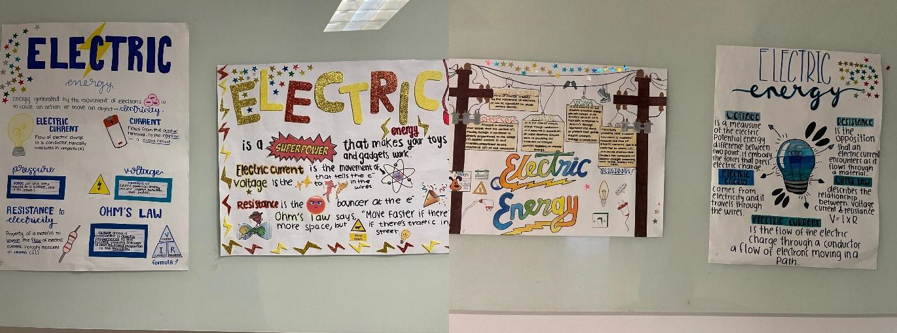
Students’ opinions about ChatGPT
To conclude the activity, I asked the students to answer a short survey through Google Forms, obtaining 57 responses (81% participation).
The survey results are explained below. Figure 2 shows that 28% of the students had never used the AI tool before.
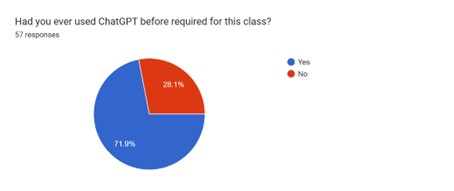
Figure 3 shows that 86% of the students surveyed thought ChatGPT was a useful tool for the preliminary research phase.
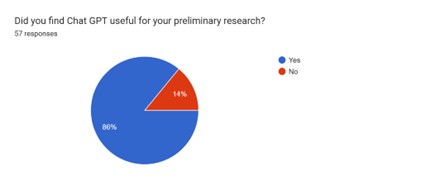
Notably, Figure 4 reveals that 19.3% of the students surveyed showed no interest in continuing to use the tool in other classes.
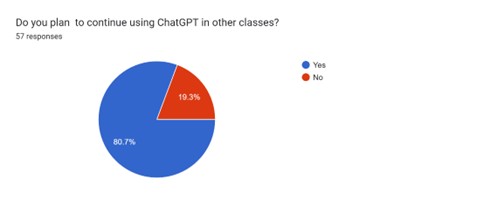
Despite the surprising “No” response to the question in Figure 4, 91.2% of students stated that they would recommend a friend to use ChatGPT (see Figure 5).
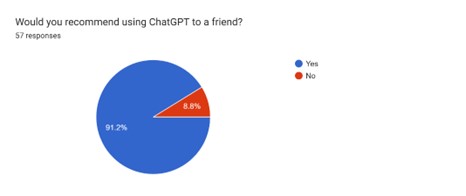
Finally, Figure 6 shows that 87.7% of the students surveyed thought the teacher should continue using artificial intelligence for preliminary research on a topic.
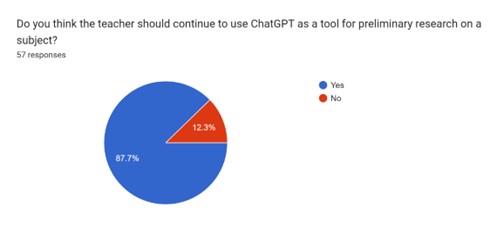
Reflection
This activity aimed to investigate the possibility of using the artificial intelligence ChatGPT as a source of information in the didactic technique of directed inquiry to develop scientific competency. I observed that it was a relevant learning activity for developing scientific disciplinary competency, a declared objective at PrepaTec.
An intriguing observation was the diversity of students’ opinions regarding the tool. Some feared it a little, felt intimidated, and did not like it, but most found it fun and with great potential. Some students noticed that the tool could make mistakes and that it is crucial to validate the information received. The students showed interest and enthusiasm in developing the research. The poster activity allowed them to expand their creativity; I received positive comments about it. The primary reservation I had concerned the possibility that the students would use the tool unethically in writing the research paper; however, this was not the case. None of the papers presented cited ChatGPT as a source. All the students looked for pertinent information from sources previously established as reliable. The quality of the articles was generally higher than in previous semesters.
The directed inquiry teaching method requires the faculty to have a deep command of the terrain they tread. The work of the research director is simulated; the professor cannot be just another member of the research team, not even the principal investigator. To help learners, the teachers must know what models and interpretations the students should use and discriminate between productive and useless questions (Pozo & Gómez, 1998). As teachers, we are the first who must continue the journey of lifelong learning. We must continue our training in using artificial intelligence as a tool, to be able to direct students with better knowledge of this subject because it is here to stay. I will continue exploring integrating this technology and others into my classes because change is the only constant.
About the Author
María Eugenia Walss Aurioles (walss@tec.mx) is a teacher at PrepaTec Laguna. She has taught mathematics and physics for more than 30 years. In 2015, she received recognition from the Laguna Campus as an Inspirational Teacher at the high school level. She is the author of the article “Ten Digital Tools to Facilitate Formative Assessment.” She currently conducts research in education about students’ attitudes towards school science. At CIIE 2023, she presented the research paper entitled “Directed Research as a Didactic Technique to Promote Positive Attitudes Toward School Science in Physics Class.” Because she complied with the highest standards for research, the PhET platform published her directed research activity on Thermal Energy with a gold star. The author received the AI Pioneer Digital Badge | Artificial Intelligence in Education for her interest in AI. https://www.credential.net/b3ebbddc-eff7-4fc1-9e46-1605b0f4ffef#gs.3s3qjv
References
Cañal, P. (2012). How to assess scientific competence? Journal of Research at School 78, 5 – 17.
Chamizo Guerrero J.A., Blancas Hernández, J.L., Reynoso Angulo, R., & Aguilar Choza, L.M. (2017). INEE: Comparative study of the science curriculum proposal in compulsory education in Mexico and other countries.
Frade, L. (2019). The desired education: a pending task in Mexico. Mediación de Calidad S.A. de C.V.
Frueh, S. (2023, November 6). How AI is Shaping Scientific Discovery. National Academies. https://www.nationalacademies.org/news/2023/11/how-ai-is-shaping-scientific-discovery?utm_source=NASEM+News+and+Publications&utm_campaign=fdbc7f38b7-EMAIL_CAMPAIGN_2023_11_06_01_40&utm_medium=email&utm_term=0_-fdbc7f38b7-%5BLIST_EMAIL_ID%5D&mc_cid=fdbc7f38b7&mc_eid=7d49c58a81
Mullin, R. (2023, September 15). The ethics of AI in the lab. Retrieved from https://cen.acs.org/business/informatics/tricky-ethics-AI-lab/101/i31?utm_source=LatestNews&utm_medium=LatestNews&utm_campaign=CENRSS
Pozo Municio, J.I., & Gómez Crespo, M.A. (1998). Learning and Teaching Science: From Everyday Knowledge to Scientific Knowledge. Ediciones Morata.
World Economic Forum (2022, May 20). This robot scientist conducted experiments by itself during COVID-19 lockdown. Retrieved from https://www.weforum.org/agenda/2020/08/robot-scientist-experiments-covid-19-lockdown/
Editing
Edited by Rubí Román (rubi.roman@tec.mx) – Editor of the Edu bits articles and producer of The Observatory webinars- “Learning that inspires” – Observatory of the Institute for the Future of Education at Tec de Monterrey.
Translation
Daniel Wetta
This article from Observatory of the Institute for the Future of Education may be shared under the terms of the license CC BY-NC-SA 4.0 
)
)
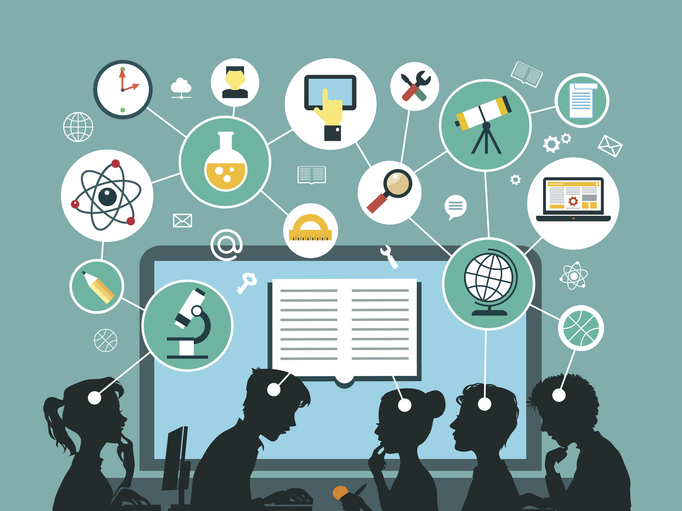

)